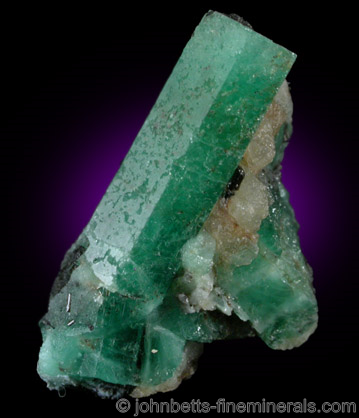The Mineral emerald

Emerald is the green variety of Beryl, and its most precious and valuable variety. Its intense green color has given it status as an important gemstone throughout the centuries. The color of Emerald is green to emerald-green. The light green form of Beryl is not recognized as Emerald, but rather Green Beryl. The deep color of Emerald is caused by traces of the element chromium, but sometimes also vanadium.
The ancient source of Emeralds in the old world was from Egypt, but their quality was not exceptional. However, the Native South American civilizations such as the Incas have had high quality Emeralds from the mines of Colombia, which have traditionally produced the highest quality Emeralds and continue doing so.
Emeralds can be transparent and gemmy, in which case they are extremely valuable, or they can be in opaque or semi-opaque forms which are much more common and not as valuable.
For additional information, see the gemstone section on Emerald.
Chemical Formula
Be3Al2Si6O18
Color
Green to emerald-green
Properties
Streak
Colorless |
Hardness
7.5 - 8 |
Transparency
Transparent to opaque |
Specific Gravity
2.6 - 2.9 |
Luster
Vitreous |
Cleavage
3,1 - basal |
Fracture
Uneven to conchoidal |
Tenacity
Brittle |
Crystal Habits
Emerald often crystallizes in perfect, six-sided hexagons. Crystals
are usually as individual prismatic hexagons. Less commonly in short, stubby crystals and crystal plates. The
bases of Beryl crystals are usually flat; pyramidal
terminations are very rare. Also occurs in columnar aggregates and in
massive. Occasionally in drusy or platy aggregates and as
bundles of thin, long crystals.
Crystals may be striated lengthwise.
Varieties
-
High-quality Emerald from the mines of Colombia of South America. These Emeralds are considered to be the highest quality.
-
Rare form of Emerald that exhibits a radiating star pattern with raylike spokes of impurities that give the Emerald a six-pointed asterisk-shaped pattern.
Uses
Emerald is one of the most valuable gemstones. It is the most famous green gemstone, and its deep emerald-green color gives it its unique status. It is used in all forms of jewelry, and less transparent stones are cut into cabochons. Good quality Emerald specimens are highly valued by collectors.
Noteworthy Localities
The finest Emeralds have historically come from the various Emerald mines of Colombia. The "Emerald Belt" in Colombia contains two concentrations of deposits where the famous Emeralds are sourced. The western belt includes the the Muzo, La Pita, and Cosquez mines, and the eastern belt includes the Chivor and Gachalá mines. Many of the Colombian Emerald mines are still producing today. Brazil has also produces many Emeralds, in Carnaiba and Socoto in Brumado, Bahia, Brazil.
Two classic old-world localities of Emerald are the Sikait-Zabara region, Egypt (known as Cleopatra's Mines); and Habachtal, Salzburg, Austria. Other important Emerald deposits are in the Panjshir Valley, Panjshir Province, Afghanistan; Dayakou, Wenshan, Yunnan Province, China; Malyshevo, near the Tokovaya River, Yekaterinburg, Ural Mountains, Russia; the Byrud Emerald Mine, Minnesund, Eidsvoll, Norway; and the Rio Maria III Mine, Gité, Zambezia Province, Mozambique. Outstanding Emeralds, close in quality to those of Colombia, come from the Kagem Emerald Mine, Ndola, Zambia. This mine has been a recent producer of high-quality gem grade Emerald.
In the U.S., Emeralds come from North Carolina at Hiddenite and Stony Point, Alexander Co.; and from Spruce Pine, Mitchell Co.
Distingushing Similar Minerals
Emerald is unique in color and crystal habit, although green Tourmaline may be similar, but is striated lenghtwise whereas Beryl is striated crosswise.